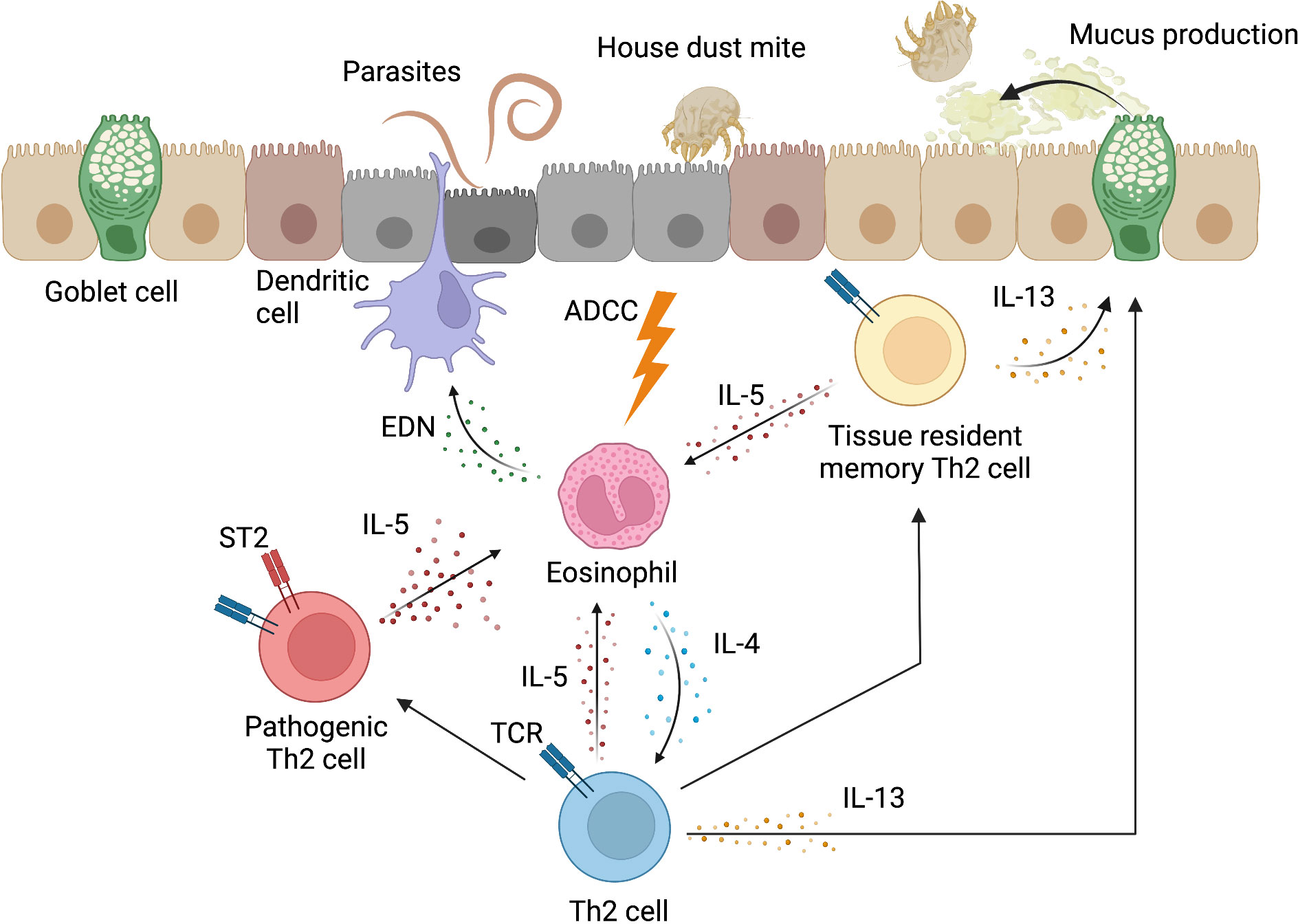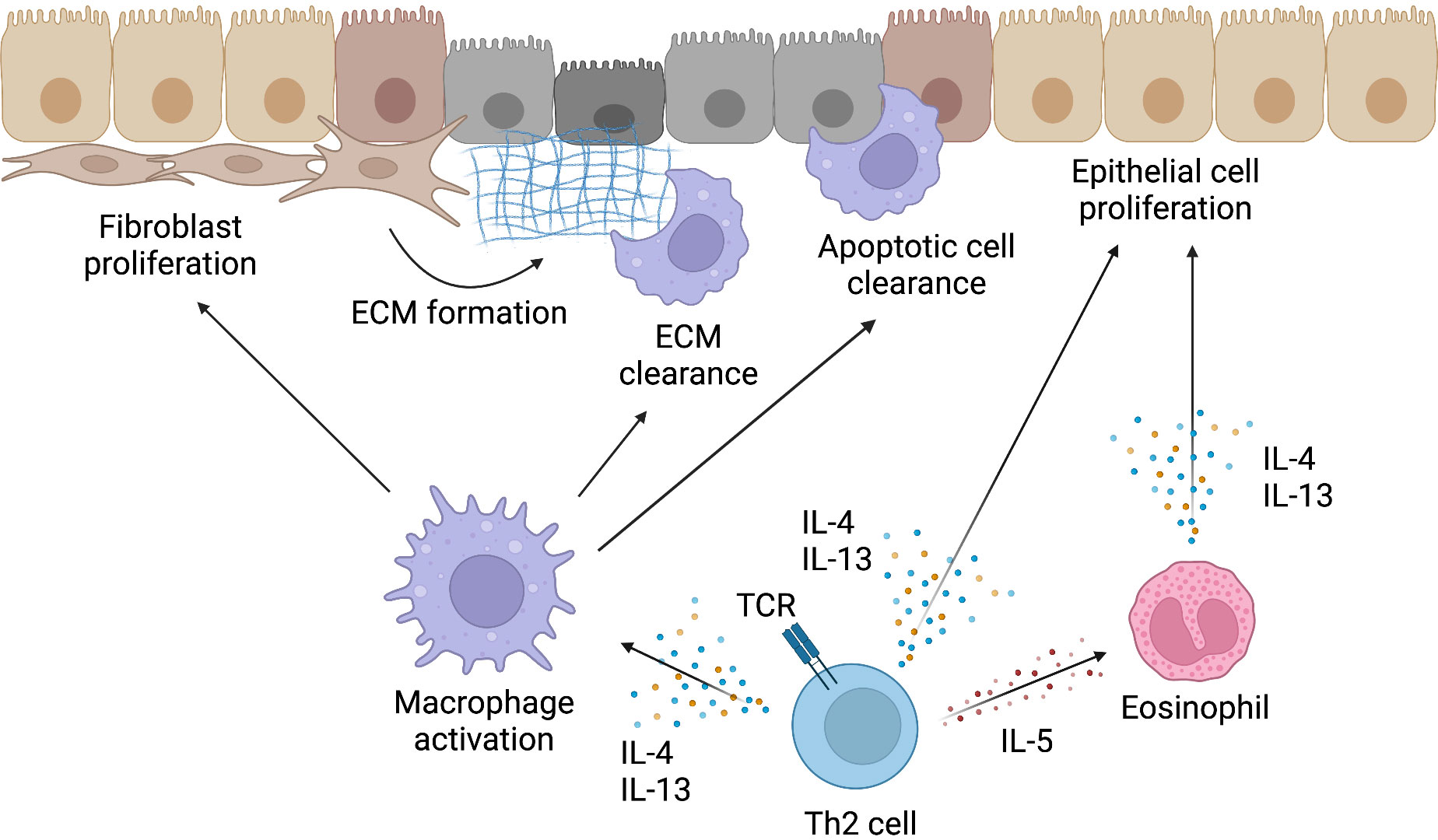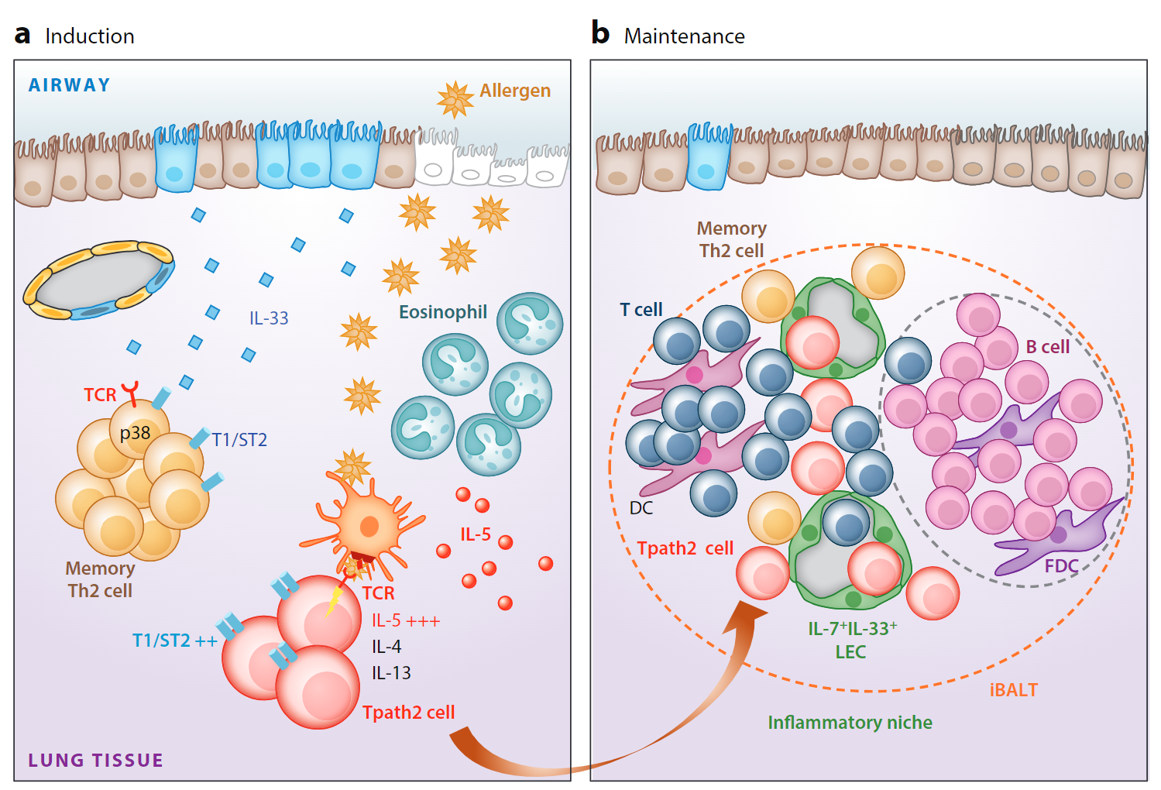Th2 Cells
Related Symbol Search List
- CXCR4
- CRLF2
- Il7
- TSLP
- CD4
- CD3e
- GATA3
- IL-10
- IL-13
- IL2
- IL-4
- Il5
- CD3G
- IFNGR1
- IL17RA
- IL21
- IL4R
- IL27
- CNOT6
- IL1RAP
- CCR3
- CCR8
- IL17RB
- ST2
- Il25
- IL31RA
- Il33
- IL9
- STAT6
Immunology Background
Available Resources Related to Th2 Cells
Creative BioMart offers a comprehensive range of products, customized services, and resources dedicated to Th2 cell research designed to support researchers in furthering their understanding of Th2 cell biology and its impact on disease, facilitating breakthrough discoveries, and contributing to the development of innovative therapies.
| Our extensive selection of premium products is specially crafted to assist in Th2 cell research. Our offerings encompass recombinant proteins, GMP proteins, protein-coupled magnetic beads, cell and tissue lysates, antibodies, chromatography reagents, assay kits, and more. | |
| We recognize the individuality of each research endeavor. Our customized services meet your specific requirements for Th2 cell research, such as custom protein services, protein analysis services, discovery and translational services, and others. | |
| In addition, we provide a wealth of resources on Th2 cell molecules, covering protein functions, protein interactions, involved pathways, and other essential data. These valuable tools serve to empower researchers by offering robust support for the progression of their research initiatives and experiments. |
About Th2 Cells
Th2 cells are a subset of CD4+ T cells that play a critical role in orchestrating immune responses associated with allergies, asthma, and certain autoimmune diseases. They are characterized by their production of specific cytokines and their involvement in humoral immunity. Th2 cells are distinct from other T cell subsets, such as Th1 and Th17 cells, both in terms of their cytokine profile and their functional properties.
Th2 cells are primarily involved in immune responses against extracellular parasites, such as helminths, and in allergic reactions. When activated by antigen-presenting cells, Th2 cells differentiate and secrete a specific set of cytokines, including interleukin-4 (IL-4), interleukin-5 (IL-5), interleukin-9 (IL-9), and interleukin-13 (IL-13). These cytokines play crucial roles in driving the activation, recruitment, and effector functions of various immune cells involved in Th2-mediated responses.
The Key Features and Functions of Th2 Cells
- Cytokine production: Th2 cells are known for their production of specific cytokines. IL-4 is a critical cytokine that promotes B cell class switching to immunoglobulin E (IgE) production, which is important in allergic responses. IL-5 plays a role in enhancing eosinophil production and recruitment, which are associated with allergic inflammation and defense against parasitic infections. IL-9 contributes to mast cell activation and is involved in allergic responses. IL-13, similar to IL-4, promotes IgE production and contributes to airway hyperresponsiveness in asthma.
- B cell help: Th2 cells provide help to B cells, promoting their differentiation into antibody-secreting plasma cells. Through the secretion of IL-4, Th2 cells induce B cells to undergo class switching to IgE and IgG1 antibody production, which are involved in allergic and humoral immune responses.
- Tissue recruitment and inflammation: Th2 cells recruit and activate eosinophils, mast cells, and basophils to sites of inflammation, particularly in allergic reactions. These cells release inflammatory mediators that contribute to tissue damage and the characteristic symptoms of allergies and asthma.
- Regulation of immune responses: Th2 cells play a role in regulating immune responses by counterbalancing the effects of Th1 cells. Th1 cells produce interferon-gamma (IFN-γ), which can inhibit Th2 cell differentiation and suppress Th2-mediated responses. The balance between Th1 and Th2 cells is crucial for maintaining immune homeostasis.
- Implications in diseases: Dysregulation of Th2 cell responses is associated with allergic diseases, including allergic rhinitis, atopic dermatitis, and asthma. In these conditions, there is an exaggerated Th2 cell response, leading to increased production of Th2 cytokines and an overactive immune response against harmless antigens.
 Fig.1 Inflammatory response induced by Th2 cells. (Kokubo K, et al., 2022)
Fig.1 Inflammatory response induced by Th2 cells. (Kokubo K, et al., 2022)
Regulatory Mechanisms of Th2 Cells
The differentiation and function of Th2 cells are tightly regulated by several mechanisms:
- Transcription factors: The differentiation of naïve CD4+ T cells into Th2 cells is orchestrated by the transcription factor GATA3. GATA3 promotes Th2 cell lineage commitment and regulates the expression of genes associated with Th2 cell function.
- Cytokines and signaling pathways: The cytokine IL-4 plays a crucial role in driving Th2 cell differentiation. IL-4 activates signal transducer and activator of transcription 6 (STAT6), which, in turn, induces GATA3 expression and promotes Th2 cell differentiation. Additionally, other cytokines, such as IL-2, IL-25, and IL-33, can also contribute to Th2 cell responses.
- Regulatory T cells (Tregs): Regulatory T cells play a role in suppressing Th2 cell responses to maintain immune homeostasis. Tregs can inhibit Th2 cell differentiation and function through various mechanisms, including the secretion of immunosuppressive cytokines, such as interleukin-10 (IL-10) and transforming growth factor-beta (TGF-β).
- Th1/Th2 balance: The differentiation of Th2 cells is influenced by the presence of other T cell subsets, particularly Th1 cells. Th1 cells produce interferon-gamma (IFN-γ), which can inhibit Th2 cell differentiation and suppress Th2-mediated responses. The balance between Th1 and Th2 cells is crucial for maintaining immune equilibrium.
Understanding the biology and regulation of Th2 cells is essential for developing targeted therapies for allergic and autoimmune diseases. Modulating Th2 cell responses and the associated cytokines can offer potential strategies for controlling allergic inflammation and related disorders.
 Fig.2 Mechanism of tissue repair by Th2 cells. (Kokubo K, et al., 2022)
Fig.2 Mechanism of tissue repair by Th2 cells. (Kokubo K, et al., 2022)
Molecules Associated with Th2 Cells Functions
Th2 cells exhibit their functions through the secretion of specific cytokines and the expression of cell surface molecules. These molecules play crucial roles in mediating the effects of Th2 cells and their interactions with other immune cells. Here are some key molecules associated with Th2 cell functions (These molecules are just examples.):
| Key molecules type | Key molecules and functions |
|---|---|
| Cytokines |
|
| Transcription Factors |
|
| Cell Surface Molecules |
|
| Immunoglobulin Receptors |
|
These molecules play integral roles in Th2 cell-mediated immune responses, including allergic reactions, asthma, and immune responses against parasites. Understanding the functions and interactions of these molecules provides insights into the complex regulation of Th2 cell biology and potential targets for therapeutic interventions in Th2 cell-associated diseases.
Role of Th2 Cell-Associated Molecules in Disease Onset and Progression
Th2 cell-associated molecules play critical roles in the onset and progression of various diseases, particularly those characterized by Th2 cell-mediated immune responses. Here are some examples of how these molecules contribute to disease pathogenesis:
Allergic Disease
Th2 cells and their associated molecules are central players in the development of allergic diseases, such as allergic rhinitis (hay fever), atopic dermatitis (eczema), and asthma. The following roles are observed:
- IgE production: Th2 cells promote B cell class switching to produce IgE antibodies, which bind to FcεRI receptors on mast cells and basophils. Upon allergen exposure, cross-linking of IgE antibodies triggers the release of inflammatory mediators, leading to allergic symptoms.
- Cytokine production: Th2 cells secrete cytokines such as IL-4, IL-5, IL-9, and IL-13, which contribute to allergic inflammation, recruitment of eosinophils, mast cell activation, mucus production, and airway hyperresponsiveness.
- Tissue remodeling: IL-13, in particular, is involved in tissue remodeling and fibrosis in chronic allergic diseases such as asthma. It promotes collagen deposition, airway smooth muscle hypertrophy, and structural changes in the airways.
Asthma
Th2 cell-associated molecules play crucial roles in the pathogenesis of asthma, a chronic inflammatory airway disease:
- Airway inflammation: Th2 cells and their cytokines, especially IL-4, IL-5, and IL-13, drive eosinophilic inflammation, recruitment of inflammatory cells, and activation of mast cells in the airways.
- Airway hyperresponsiveness: IL-4 and IL-13 contribute to airway smooth muscle contraction and enhanced bronchial responsiveness, leading to symptoms such as wheezing and shortness of breath.
Mucus production: Th2 cell-derived cytokines stimulate goblet cell hyperplasia and mucus production in the airways, leading to airway obstruction and impaired lung function.
Atopic Dermatitis
Th2 cell-associated molecules contribute to the development of atopic dermatitis, a chronic inflammatory skin condition:
- Epidermal barrier dysfunction: Th2 cell-derived cytokines, particularly IL-4 and IL-13, disrupt the skin barrier function by inhibiting the production of proteins that maintain skin integrity, such as filaggrin. This leads to increased permeability and susceptibility to allergens and irritants.
- Inflammatory cell recruitment: Th2 cells and their cytokines promote the recruitment of inflammatory cells, including eosinophils and mast cells, to the skin, leading to inflammation, itching, and skin lesions.
- Immunoglobulin production: Th2 cells drive the production of IgE antibodies, which bind to mast cells in the skin. Upon exposure to specific allergens, cross-linking of IgE antibodies triggers the release of inflammatory mediators, exacerbating skin inflammation and itching.
Parasitic Infections
Th2 cells and their associated molecules play a crucial role in immune responses against parasitic infections, particularly helminth infections:
- Eosinophil activation: Th2 cell-derived cytokines, notably IL-5, stimulate the activation, recruitment, and survival of eosinophils, which are important in defense against helminths.
- Mucus production and smooth muscle contraction: IL-4 and IL-13 contribute to mucus production and smooth muscle contraction in the gastrointestinal tract, aiding in the expulsion of parasitic worms.
- IgE production: Th2 cells drive the production of parasite-specific IgE antibodies, which can facilitate the clearance of parasites by activating effector mechanisms such as antibody-dependent cell-mediated cytotoxicity (ADCC).
Understanding the roles of Th2 cell-associated molecules in disease onset and progression provides important insights into the underlying mechanisms of allergic diseases, asthma, atopic dermatitis, and immune responses against parasitic infections. Targeting these molecules and related pathways may offer potential strategies for the development of therapeutic interventions to modulate the immune response and ameliorate disease symptoms.
 Fig.3 Induction and maintenance of memory-type pathogenic Th2 (Tpath2) cells in the airway. (Nakayama T, et al., 2017)
Fig.3 Induction and maintenance of memory-type pathogenic Th2 (Tpath2) cells in the airway. (Nakayama T, et al., 2017)
For more information, please explore our website or contact us today to learn more about how we can support your research endeavors.
Related References
- Walker JA, McKenzie ANJ. TH2 cell development and function. Nat Rev Immunol. 2018;18(2):121-133.
- Kokubo K, Onodera A, Kiuchi M, Tsuji K, Hirahara K, Nakayama T. Conventional and pathogenic Th2 cells in inflammation, tissue repair, and fibrosis. Front Immunol. 2022;13:945063.
- Nakayama T, Hirahara K, Onodera A, et al. Th2 cells in health and disease. Annu Rev Immunol. 2017;35:53-84.
- Jacenik, D., Karagiannidis, I. & Beswick, E.J. Th2 cells inhibit growth of colon and pancreas cancers by promoting anti-tumorigenic responses from macrophages and eosinophils. Br J Cancer 128, 387–397 (2023).

